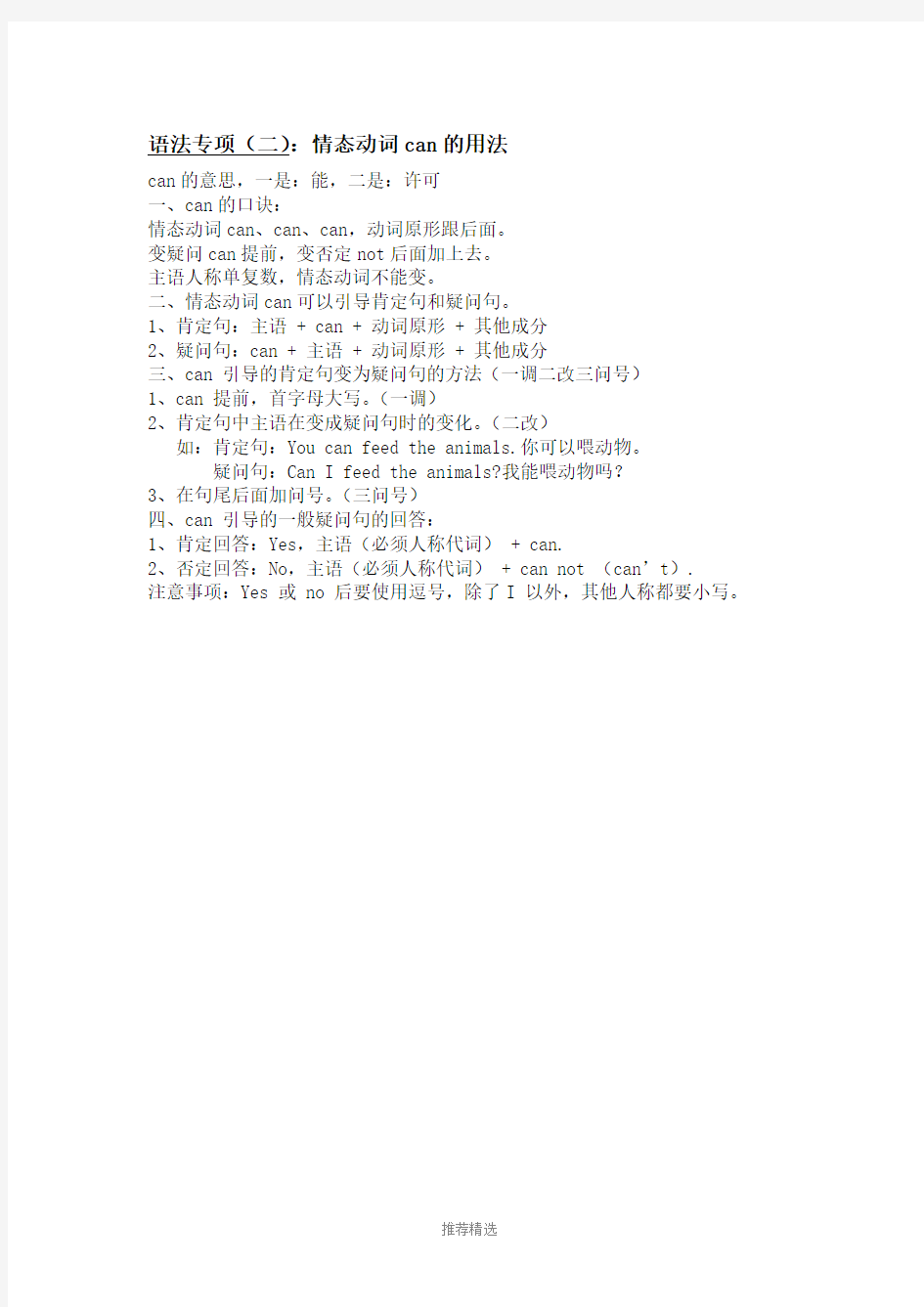牛津小学英语5A语法汇总


牛津小学英语5A语法汇总
语法专项(一):There be 句型
结构:(1) There is +单数可数名词/不可数名词
(2) There are +复数名词
例:There is a cup on the desk.
There is some coffee in the cup.
There are some cups on the desk.
句型转换:
(1)改成否定句:
There be句型的否定式,在be后加上not。some 改成 any
例:There are some pictures on the wall.
→ There aren't any pictures on the wall.
There are no pictures on the wall.
(2)改成一般疑问句:
There be句型的一般疑问句变化,把be动词放到句首,其它照抄,some 改为any
肯定回答:Yes,there is. 或 Yes, there are.
否定回答:No, there isn’t. 或 No,there aren’t.
例:There is a bike behind the tree.
→ Is there a bike behind the tree?
肯定回答:Yes, there is. 否定回答:No, there isn’t.
There are some birds on the tree.
→ Are there any birds on the tree?
肯定回答:Yes, there are. 否定回答:No, there aren’t.
考点:“就近原则”
例:There is a cup on the desk.
There is a cup and two eggs on the desk.
There are two eggs and a cup on the desk.
语法专项(二):情态动词can的用法
can的意思,一是:能,二是:许可
一、can的口诀:
情态动词can、can、can,动词原形跟后面。
变疑问can提前,变否定not后面加上去。
主语人称单复数,情态动词不能变。
二、情态动词can可以引导肯定句和疑问句。
1、肯定句:主语 + can + 动词原形 + 其他成分
2、疑问句:can + 主语 + 动词原形 + 其他成分
三、can 引导的肯定句变为疑问句的方法(一调二改三问号)
1、can 提前,首字母大写。(一调)
2、肯定句中主语在变成疑问句时的变化。(二改)
如:肯定句:You can feed the animals.你可以喂动物。
疑问句:Can I feed the animals?我能喂动物吗?
3、在句尾后面加问号。(三问号)
四、can 引导的一般疑问句的回答:
1、肯定回答:Yes,主语(必须人称代词) + can.
2、否定回答:No,主语(必须人称代词) + can not (can’t).
注意事项:Yes 或 no 后要使用逗号,除了I 以外,其他人称都要小写。
1.基本用法
like +可数名词复数表示喜欢某一类东西
例: like horse s喜欢马、like peach es喜欢桃子
【注意:复数名词s 不能少】
2.like+定冠词the/this/that 表示特指,喜欢某一件物体。
例:I like this car. 喜欢这辆车
3.like +动词-ing 表示喜欢做某事
例: like read ing喜欢阅读 like danc ing 喜欢跳舞
【注意:只有动词才有ing 形式,可数名词有复数形式加s、es、等】
2.句型
肯定句: 主语+ like……
例:My parents like read ing .
否定句: 主语+ don’t + like……
例: My parents don’t like read ing .
一般疑问句: Do+主语+like…? Yes,主语+do. / No, 主语+don’t.
例:Do your parents like read ing?
肯定回答: Yes, they do .
否定回答: No , they don’t .
特殊疑问句: What do +主语+ like?
例:What do your parent s like ?
【进行句型转换时, I 和 we 要改为 you , my 和 our 要改为 you r , some 要改为any 】
3.注意
(1)can 和like 的区别
can 是情态动词+动词原形
like +动词-ing
例: I can dance .(动词原形)
I like dancing . (动词-ing )
(2)like 和would like 的区别
①like (1) like +可数名词复数表示喜欢某一类东西
(2) like +动词-ing 表示喜欢做某事
②would like (1) would like + 名词想要某物
(2) would like + to + 动词原形想要做某事
例: I’d like some ice creams . (名词)我想要一些冰淇淋.
I’d like to have an ice cream .(动词原形词组)我想要吃一个冰淇淋.
1.定义
现在进行时表示现在正在进行或发生的动作,也可表示当前一段时间内的活动或现阶段正在进行的动作。
2. 结构
be(am/is/are)+动词的现在分词(动词+ing)
动词加ing的变化规则
(1)一般情况下,直接加ing,如:cook-cooking
(2)以不发音的e结尾,去e加ing,如:make-making, taste-tasting (3)如果末尾是一个元音字母和一个辅音字母,双写末尾的辅音字母,再加ing,如:run-running, stop-stopping sit-sitting get-getting run-running forget-forgetting begin-beginning
(4)以ie结尾的动词,改ie为y加ing ,如:die--dying lie—lying 3.句型
be+动词ing.
be后加not。
be动词调到句首。
疑问词+ be + 主语 + 动词ing? 如:What are you doing? 你正在做什么?*但疑问词当主语时其结构为:疑问词 + be + 动词ing? 如: Who is singing over there?
语法专项(五):have 和has的用法
(一)用法:第三人称单数用“has”表示有,其余人称用“have”有。
练习:用be动词和have, has填空
1. ______ you a boy? No, I _____ not.
2. The girl______
Jack's sister.
3. I _ some red ink (一些红墨水).
4. His father an old car.
5. The dog _______ tall and fat(又高又胖).
6. ______ your brother(哥哥) in the classroom?
7. You _ two big eyes. 8. Their parents(他
们的父母) many friends.
9. Mike and Liu Tao ______ at school(在学校). 10. Whose dress
(谁的裙子) ______ this?
11. Whose socks(谁的袜子)______ they? 12. Who ______
I?
(二)含have、has的句子变否定句、一般疑问句及肯定回答和否定回答
变否定句:have → don’ t have has → doesn’ t have
变一般疑问句:have → Do … have …? has → Does … have …?
注:I / we → you my / our → your
练习:把下列句子改为否定句、一般疑问句,并作出肯定回答和否定回答。
1. I have many friends.
2. He has a computer
(电脑).
3. He has three pens.
4. They have sandwiches(三明治).
(注:可编辑下载,若有不当之处,请指正,谢谢!)
